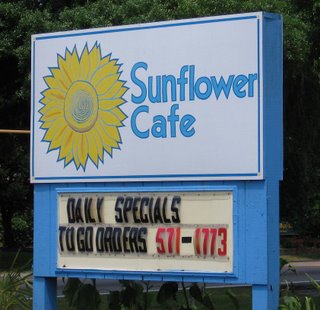
Lex Culinaria's
Summer Barbeque Challenge asks bloggers to step outside their comfort zones and come up with interesting barbecue dishes so we all don't have to keep coming back to the same old set of standbys we always use. My approach is not to come up with something new and creative but rather to go old school--really old school--and try the flavor of America's original barbecues. And, a good place to start is with barbecue sauce.
Barbecue fans know that the sauce served with ribs, brisket, and pulled pork varies greatly from one part of the United States to another. The American Barbecue Belt can be divided into distinct “sauce zones” defined by the dominant ingredients in their native concoctions--vinegar-based in North Carolina, mustard-based in central South Carolina, molasses-and-tomato based in Kansas City, etc. Over the past 20 years, the bottled barbecue sauce business--long dominated by a few brands from Kraft and Heinz--has blossomed, and dozens of varieties from many different regions can be found on the typical supermarket shelf. But, as entrenched as these products are in American backyard cooking, barbecue sauce as we know it today is a relatively recent development.
Barbecue originated among the Caribbean and North American Indian tribes before the arrival of Europeans to the New World. British colonists adopted both the word and the cooking technique from the Native Americans, and over time it took on the additional meanings of a dish cooked in such a manner as well as the social event at which the food is served--such as the backyard barbecue.
Americans had been cooking barbecue for more than a century before the first instructions for preparing it began appearing in print. The earliest recipe for pit-cooking barbecue is likely the one in Lettice Bryan’s
The Kentucky Housewife (1839), which calls for only the simplest of basting sauces: “nothing but a little salt-water and pepper, merely to season and moisten it a little.” Once the meat was done, Bryan recommended the cook “squeeze over it a little lemon juice, and accompany it with melted butter.”
Three decades later, Mrs. Annabella Hill, from La Grange, GA, published similar directions in
Mrs. Hills New Cook Book (1872), though her recipe incorporates butter and a little mustard into the basting liquid: "Melt half a pound of butter; stir into it a large tablespoon of mustard, half a teaspoonful of red pepper, one of black, salt to taste; add vinegar until the sauce has a strong acid taste.” At the end of cooking, “pour over the meat any sauce that remains.”
This basic combination of butter or some other fat, vinegar, and pepper remained the standard barbecue sauce throughout the 19th Century. An 1860 account of a Virginia event described iron vessels positioned along the side of the pit, ”some filled with salt, and water; others with melted butter, lard, etc. into which the attendants dipped linen cloths affixed to the ends of long, flexible wands, and delicately applied them with a certain air of dainty precision to different portions on the roasting meat.” In 1896,
Harper’s Weekly described a Georgia barbecue and noted that the meat was cooked for twelve hours and “basted with salt water . . . then, just before it is eaten, plentifully bedabbled with ‘dipney’—a compound of sweet country lard and the strongest vinegar, made thick and hot with red and black pepper.”
Today, eastern barbecue sauces couldn't be more different from their Texas counterparts, but
On a Mexican Mustang Through Texas, an 1883 travelogue, described a barbecue outside San Antonio with a sauce almost identical to that used in Virginia and Georgia: “Butter, with a mixture of pepper, salt, and vinegar, is poured on the meat as it is being cooked.” The famed regional variations in barbecue sauces apparently did not develop until the 20th Century.
Early barbecue sauces were simple, prepared in bulk, and used only basic staples for ingredients. One notable feature of the old recipes is that they did not include sugar. That addition began appearing in cookbooks in the 1920s. Around the same time, a variety of other new ingredients began working their way into the sauces, many of them commercially-prepared products such as ketchup and Worcestershire sauce. By World War II, barbecue sauce had evolved from a thin, peppery basting liquid to a sweet, cooked product with a mix of many flavors.
The addition of sugar to barbecue sauce altered its nature, making it thicker and turning it into something that, like ketchup, can be poured directly onto meat in large quantities. Sugar caramelizes and burns when exposed to direct heat, so using such sauces to baste cooking meat can lead to a charred, blackened crust. For this reason, barbecuists typically wait until the end of cooking to pour on the sauces or use a separate low-sugar “mopping sauce” during cooking and save the sweet stuff until serving time.
The addition of sugar to barbecue sauces seems to have changed the way people eat barbecue. Modern sauces are thicker and sweeter than the original varieties, and when slathered on at the end of cooking they can overpower the natural smoked flavor of the meat. As a result, many cooks these days devote less attention to the cooking process because they can just dollop on a lot of flavor at the end. They can now use electric cookers and gas grills to get a crispy grilled crust on the meat and rely on the sauce for the flavor. The addition of liquid wood smoke to barbecue sauces has completed this process. Now, you can pour half a bottle of K.C. Masterpiece over some chicken parts, slap them in a 350 degree over for an hour, and—voila—barbecued chicken!
So, my new approach for the backyard barbecue is to go old school. If you want to get serious about it, you can dig a pit in the ground and burn your own hickory and oak logs down to coals--that's how it was done in the 19th Century. But, you can compromise a little and use charcoal and a modern kettle grill and still get meat that is smoky and flavorful. Here's how I do barbecue chicken the classic way:
1. Build a charcoal fire in your grill (I prefer using a
chimney starter). While it's burning, soak 2 handfuls of hickory wood chips in a bowl of water.
2. While the charcoal is burning down, prepare the barbecue sauce Start with about a cup of vinegar (apple cider and/or white) and add in a bunch of salt, black pepper, and red pepper. I don't have any set formula here, but you want to end up with salty, hot vinegar.
3. Take two whole chickens and split them down the middle so you have four chicken halves. Place in a large baking dish and brush them down well with the vinegar sauce, reserving the rest of the sauce for basting during cooking.
4. When the coals have burned down to glowing embers, spread them evenly in the grill.
5. Drain the hickory chips and scatter them across the hot coals. If any of them catch fire and start flaming, give them a minute or two to burn.
6. Place the chicken halves on the grill (inner part downward) and brush with more of the vinegar sauce. Put the lid on the grill and let them smoke.
I wish I could say I had more of a method from here, but essentially I let the chicken smoke undisturbed on the grill as long as I can--at least an hour. Sometime's I'll open the lid and peek in to see how things are going, but usually I try not to disturb it. Sometimes if I open the lid I'll dab on some more of the basting sauce; other times I leave it alone. It always seems to come out just fine. I would recommend piercing the chicken down to the thigh bone before serving, though, to make sure it is cooked through. If the grill has gone cold and you still have red juices, you can finish the cooking in a 350 degree oven.
The key is the hickory chips, which impart the rich, smoky flavor (and that distinctive mahogany smoke ring a quarter of an inch or so into the chicken), and the sauce, which leaves the outer skin salty, spicy, and delicious but doesn't get in the way of the smoky flavor. I have a refrigerator full of various types of bottled barbecue sauces, but my wife and I don't use them at all with this barbecue chicken. The meat itself carries the day.









